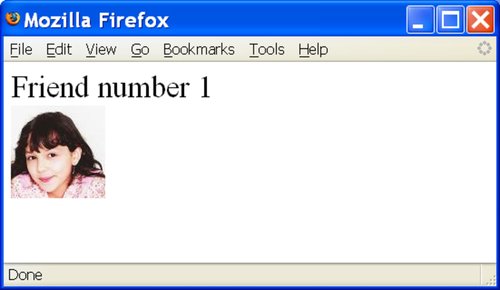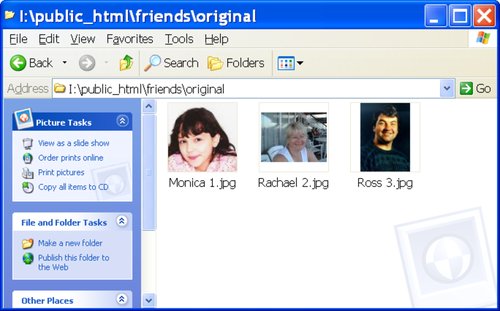Hack 46. Store Images in a Database


Most database servers can handle large binary objects such as images. But you can also handle images using files.
You can deal with large data items in a database in a number of different ways. You can use BLOBs and store the data in the database, or store the data in files and store only a reference to the file in the database.
6.6.1. Use a BLOB
A BLOB is a binary large object. You can use a column such as this to store images, sounds, or other binary large objects. You can create a table with a BLOB column:
CREATE TABLE friends (id INTEGER PRIMARY KEY ,name VARCHAR(20) ,img BLOB )
MySQL and Oracle use the term BLOB. SQL Server allows the IMAGE data type; this is not restricted to image data, despite its name. The VARBINARY(max) type is available in SQL Server 2005. In PostgreSQL, you can use the OID data type.
To get data into a BLOB you can use an API such as the DBI interface in Perl:
#!/usr/bin/perl
use strict;
use DBI;
my ($id,$img) = (shift,shift);
die "Usage $0 id img" if ! $img;
my $dbh=DBI->connect('DBI:mysql:dbname','scott','tiger')
or die 'Connect failed';
my $sth = $dbh->prepare("INSERT INTO friends(id,img) VALUES (?,?)");
open A, $img;
my $bin;
read A, $bin, -s A;
$sth->execute($id,$bin);
The $img variable is a filename; Perl opens the file and copies the contents into the $bin variable. The read instruction on the second-to-last line tells the system to read in s A bytes, where s is Perl syntax for the file size.
In MySQL, you can also use LOAD_FILE('/path/to/file.png') in an INSERT statement, for example. In PostgreSQL, you can use the large object import function, lo_import('/path/to/file.png').
Getting the data in is only half the problem. You also need to get the data out. Here is how to retrieve an image and display it from a database. The Perl script shown here will allow a user to navigate to images in friends:
#!/usr/bin/perl
use strict;
use DBI;
use CGI qw(:standard);
import_names;
if ($Q::id){
print header( );
print "Friend number $Q::id
";
print " ";
}elsif ($Q::img =~ /^d+$/){
my $dbh=DBI->connect("DBI:mysql:dbname",'scott','tiger');
my ($bin) = $dbh->selectrow_array(
"SELECT img FROM friends WHERE id=$Q::img");
print header('image/jpeg');
print $bin;
}else{
print header( );
print "Choose your friend <a href="?id=1">1</a> <a href="?id=2">2</a>";
}
";
}elsif ($Q::img =~ /^d+$/){
my $dbh=DBI->connect("DBI:mysql:dbname",'scott','tiger');
my ($bin) = $dbh->selectrow_array(
"SELECT img FROM friends WHERE id=$Q::img");
print header('image/jpeg');
print $bin;
}else{
print header( );
print "Choose your friend <a href="?id=1">1</a> <a href="?id=2">2</a>";
}
Showing a page such as friends.pl?id=1, shown in Figure 6-9, involves two HTTP calls. The page generated looks like this:
Friend number 1
Figure 6-9. The friends.pl?id=1 web page

The img element is a reference to the same script, but with the img CGI parameter set.
The browser will read this and generate a second HTTP call to the same location, but this time the CGI variable img will be set. The second call results in a database lookup. The binary object is retrieved and sent to the browser, preceded by the appropriate MIME header.
6.6.2. Use a File for Your Image
In contrast to storing images in a database, you can store the images in a separate directory and stick to the convention that the filename is the primary key of the nonimage data plus the .jpg extension. Your code to display the page is simpler and you are not using the database or your application to pump binary large objects around.
Managing a large number of images using the filesystem can be perplexing if the name of the file has to be simply a primary key. You can be kinder to your users and allow them a more flexible filenaming convention.
For example, they can call the images anything they like, as long as the primary key is included in a consistent manner, as shown in Figure 6-10.
Figure 6-10. The filename ending with the primary key

The full filename of the file is irrelevant to the web script. It uses only the last few characters of the name. You can write a script to copy these files from the original directory into another location suitable for the web server:
#!/usr/bin/perl
my @fl = glob("original/*");
foreach (@fl){
if (/(d)+.jpg/){
my $originalName = $_;
my $primaryKey = $1;
my $sh = "cat '$originalName'|jpegtopmn|".
"pnmscale --height 40|pnmtojpeg > ".
"small/$primaryKey.jpg";
print "$sh
";
}
else {
print "The file $_ does not follow the agreed naming convention.
";
}
}
The Perl script shown loops over every file in the originals directory.
For each file with the correct format, it scales the image down to 40 pixels high and copies it to the small directory. The new filename is simpler; it is the primary key followed by the .jpg suffix. With this simpler name, you can conveniently reference images from the HTML pages.
The pnm library used here contains many options for changing images; you can convert formats, crop, and scale.
SQL Fundamentals
- SQL Fundamentals
- Hack 1. Run SQL from the Command Line
- Hack 2. Connect to SQL from a Program
- Hack 3. Perform Conditional INSERTs
- Hack 4. UPDATE the Database
- Hack 5. Solve a Crossword Puzzle Using SQL
- Hack 6. Dont Perform the Same Calculation Over and Over
Joins, Unions, and Views
- Joins, Unions, and Views
- Hack 7. Modify a Schema Without Breaking Existing Queries
- Hack 8. Filter Rows and Columns
- Hack 9. Filter on Indexed Columns
- Hack 10. Convert Subqueries to JOINs
- Hack 11. Convert Aggregate Subqueries to JOINs
- Hack 12. Simplify Complicated Updates
- Hack 13. Choose the Right Join Style for Your Relationships
- Hack 14. Generate Combinations
Text Handling
- Text Handling
- Hack 15. Search for Keywords Without LIKE
- Hack 16. Search for a String Across Columns
- Hack 17. Solve Anagrams
- Hack 18. Sort Your Email
Date Handling
- Date Handling
- Hack 19. Convert Strings to Dates
- Hack 20. Uncover Trends in Your Data
- Hack 21. Report on Any Date Criteria
- Hack 22. Generate Quarterly Reports
- Hack 23. Second Tuesday of the Month
Number Crunching
- Number Crunching
- Hack 24. Multiply Across a Result Set
- Hack 25. Keep a Running Total
- Hack 26. Include the Rows Your JOIN Forgot
- Hack 27. Identify Overlapping Ranges
- Hack 28. Avoid Dividing by Zero
- Hack 29. Other Ways to COUNT
- Hack 30. Calculate the Maximum of Two Fields
- Hack 31. Disaggregate a COUNT
- Hack 32. Cope with Rounding Errors
- Hack 33. Get Values and Subtotals in One Shot
- Hack 34. Calculate the Median
- Hack 35. Tally Results into a Chart
- Hack 36. Calculate the Distance Between GPS Locations
- Hack 37. Reconcile Invoices and Remittances
- Hack 38. Find Transposition Errors
- Hack 39. Apply a Progressive Tax
- Hack 40. Calculate Rank
Online Applications
- Online Applications
- Hack 41. Copy Web Pages into a Table
- Hack 42. Present Data Graphically Using SVG
- Hack 43. Add Navigation Features to Web Applications
- Hack 44. Tunnel into MySQL from Microsoft Access
- Hack 45. Process Web Server Logs
- Hack 46. Store Images in a Database
- Hack 47. Exploit an SQL Injection Vulnerability
- Hack 48. Prevent an SQL Injection Attack
Organizing Data
- Organizing Data
- Hack 49. Keep Track of Infrequently Changing Values
- Hack 50. Combine Tables Containing Different Data
- Hack 51. Display Rows As Columns
- Hack 52. Display Columns As Rows
- Hack 53. Clean Inconsistent Records
- Hack 54. Denormalize Your Tables
- Hack 55. Import Someone Elses Data
- Hack 56. Play Matchmaker
- Hack 57. Generate Unique Sequential Numbers
Storing Small Amounts of Data
- Storing Small Amounts of Data
- Hack 58. Store Parameters in the Database
- Hack 59. Define Personalized Parameters
- Hack 60. Create a List of Personalized Parameters
- Hack 61. Set Security Based on Rows
- Hack 62. Issue Queries Without Using a Table
- Hack 63. Generate Rows Without Tables
Locking and Performance
- Locking and Performance
- Hack 64. Determine Your Isolation Level
- Hack 65. Use Pessimistic Locking
- Hack 66. Use Optimistic Locking
- Hack 67. Lock Implicitly Within Transactions
- Hack 68. Cope with Unexpected Redo
- Hack 69. Execute Functions in the Database
- Hack 70. Combine Your Queries
- Hack 71. Extract Lots of Rows
- Hack 72. Extract a Subset of the Results
- Hack 73. Mix File and Database Storage
- Hack 74. Compare and Synchronize Tables
- Hack 75. Minimize Bandwidth in One-to-Many Joins
- Hack 76. Compress to Avoid LOBs
Reporting
- Reporting
- Hack 77. Fill in Missing Values in a Pivot Table
- Hack 78. Break It Down by Range
- Hack 79. Identify Updates Uniquely
- Hack 80. Play Six Degrees of Kevin Bacon
- Hack 81. Build Decision Tables
- Hack 82. Generate Sequential or Missing Data
- Hack 83. Find the Top n in Each Group
- Hack 84. Store Comma-Delimited Lists in a Column
- Hack 85. Traverse a Simple Tree
- Hack 86. Set Up Queuing in the Database
- Hack 87. Generate a Calendar
- Hack 88. Test Two Values from a Subquery
- Hack 89. Choose Any Three of Five
Users and Administration
- Users and Administration
- Hack 90. Implement Application-Level Accounts
- Hack 91. Export and Import Table Definitions
- Hack 92. Deploy Applications
- Hack 93. Auto-Create Database Users
- Hack 94. Create Users and Administrators
- Hack 95. Issue Automatic Updates
- Hack 96. Create an Audit Trail
Wider Access
- Wider Access
- Sharing Data Across the Internet
- Hack 97. Allow an Anonymous Account
- Hack 98. Find and Stop Long-Running Queries
- Hack 99. Dont Run Out of Disk Space
- Hack 100. Run SQL from a Web Page
Index
EAN: 2147483647
Pages: 147
- Chapter II Information Search on the Internet: A Causal Model
- Chapter IV How Consumers Think About Interactive Aspects of Web Advertising
- Chapter X Converting Browsers to Buyers: Key Considerations in Designing Business-to-Consumer Web Sites
- Chapter XI User Satisfaction with Web Portals: An Empirical Study
- Chapter XV Customer Trust in Online Commerce
